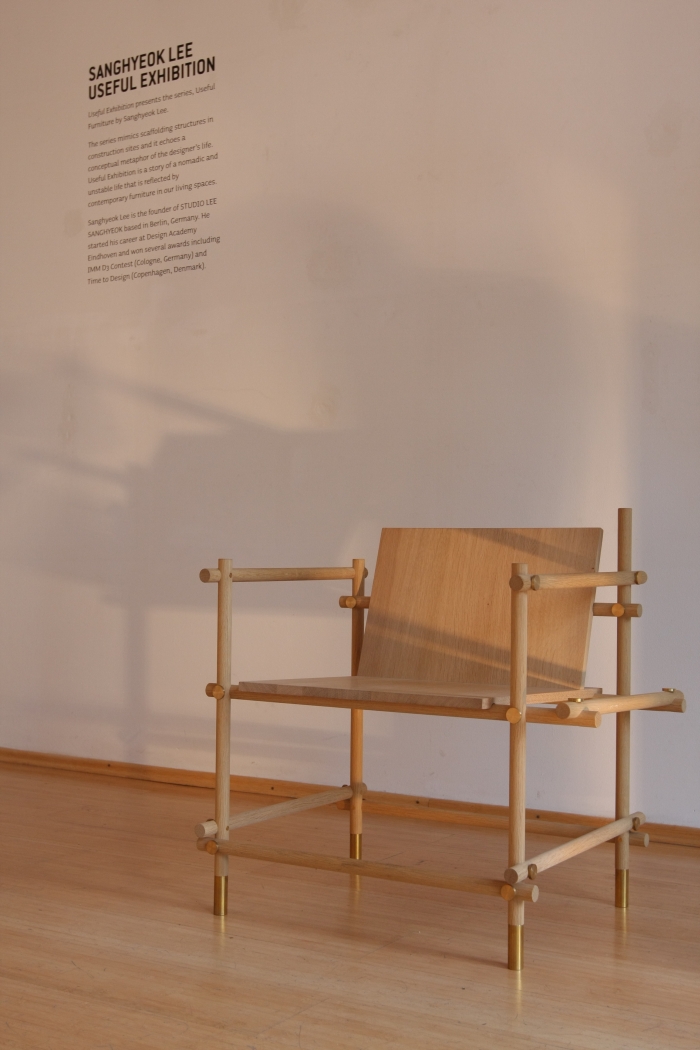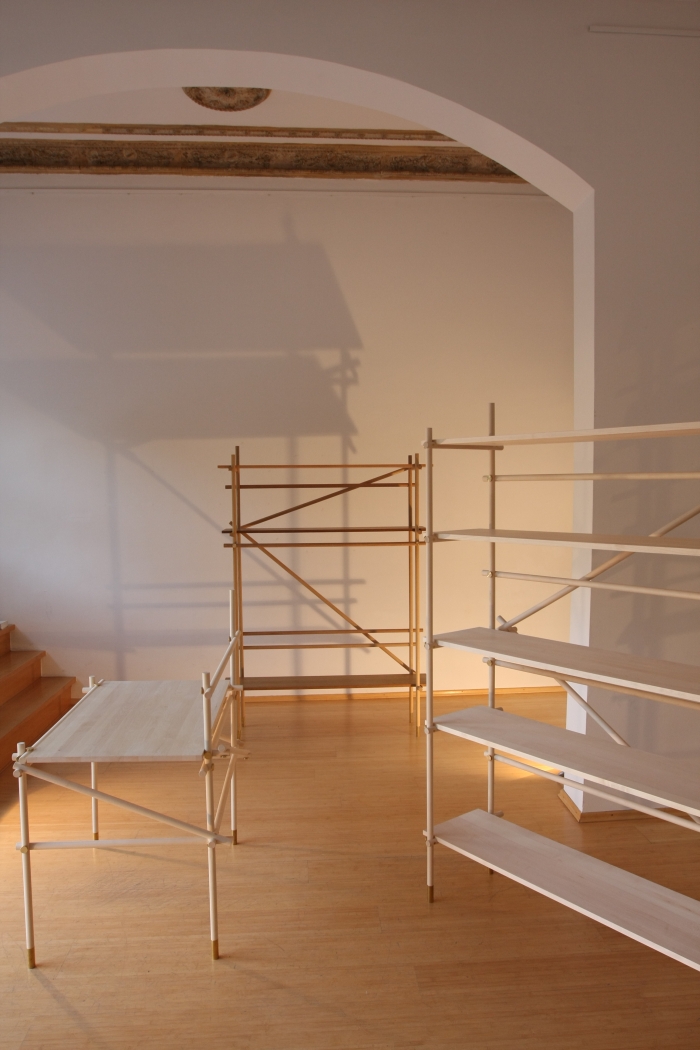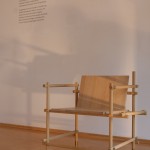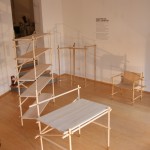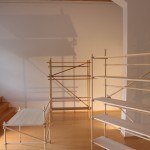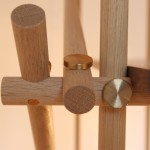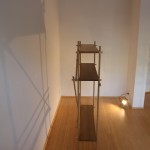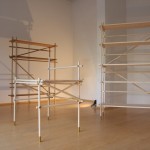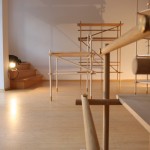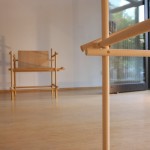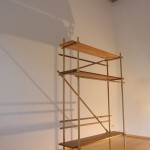Useful Exhibition by Sanghyeok Lee at the DMY Design Gallery Berlin
Charlotte Perriand was famously of the opinion that in terms of furniture design wood was a “… vegetable substance, bound in its very nature to decay,….” and that the future belonged to metal. For all the bent steel tubing of European modernism.1
Poul Henningsen in contrast warned that the industrial production of steel tube furniture as promoted by Perriand, Le Corbusier, the Bauhaus clique and their ilk “maa ogsaa føre til, at de sekundære Former ved Stolen” – may also lead to secondary types of chairs – and that, all things considered, wood was preferable for the manufacturer of furniture.2
It’s fair to say that the merits and otherwise of such arguments dominated our thoughts as we viewed the exhibition “Useful Exhibition” by Berlin based, South Korean designer Sanghyeok Lee at the DMY Design Gallery Berlin, for although crafted from oak and maple the shelving, desk, table and chair on display not only could be crafted from metal, but are inspired by a construction principle that traditionally employs metal.
Following an initial course of of product design studies in his native Seoul Sanghyeok Lee transferred to the Design Academy Eindhoven in 2007, graduating from the course Man and Living in 2011. Whereupon he immediately moved to Berlin; not least because of the positive creative environment in the city and the opportunities he felt existed there.
Having first reached an international audience when he won second place at the 2012 D3 Design Talents Contest with his graduation project “Listen to your hands” – an interactive desk where closing one drawer too quickly causes another drawer to open and which thus forces the user to consider not only how they use furniture but their relationship to their furniture in general – Sanghyeok Lee continued this exploration of furniture as companions of the human state rather than simply passive objects with his 2013 project Useful Arbeitsloser (Jobless), a furniture collection which reflects both the contemporary desire for uncluttered, personal home environments and Sanghyeok Lee’s own feeling of enforced inactivity upon arriving in Berlin and, thanks to Visa, administrative and language issues, finding himself effectively unemployed. In 2014 Sanghyeok Lee developed the idea further into the Useful Living system which rather than simply reflecting as Useful Arbeitsloser had, sought and seeks to offer solutions, to make suggestions as to how one can and should lead and live ones life in contemporary metropoli.
Structurally reminiscent of cladding-less USM Haller units, Egon Eiermann’s eponymous table frame, Rejon’s eponymous armchair and many of the early Bauhaus and De Stijl era furniture designs, the Useful Arbeitsloser and Useful Living systems were and are inspired by scaffolding and as with scaffolding the real heart of the system is not the obvious rods and panels but the otherwise innocuous connection joint: in the case of Sanghyeok Lee’s systems a beautifully refined brass screw which joins the wooden rods in combination with a very neatly executed half dado joint construction.
Unlike scaffolding however, and despite an aesthetic that suggests otherwise, the systems aren’t modular, rather come with their form predetermined. Deliberately so. “Another modular system would be boring” says Sanghyeok Lee, smiling broadly, before quickly adding, “but also the idea is to suggest new possibilities to the user, to challenge and inspire.”
Those who know us know our hang towards modular systems. And for those who don’t know us: little makes as much sense as a well thought through modular building or furniture system. The “Useful” projects however aren’t furniture systems in the classical sense, nor can they be considered in the functionalist tradition from which most modular furniture originates; rather they are concepts about modern living, positions on contemporary urban life, concepts and positions that can be used as furniture. The chair however isn’t designed for comfort. The desk isn’t designed to adapt to the worker. The shelves won’t fit in with your book and record collections. You have to adapt to them. Understand them and learn to live with them. And so while we continue to agree 100% with Rudolf Horn’s assertion that “consumers must be able to decide. No-one should tell them what they need and what to buy!” we also accept that part of the job of a designer is to challenge conventions, reflect modern society and pose questions. And sometimes that involves placing objects before us and telling us to make use of them as they are.
In addition we can easily overlook the lack of modularity because in his design Sanghyeok Lee avoids all unnecessary bulk and consequently has produced an elegant furniture collection that is unobtrusive, restrained yet has a comforting permanency. A situation delightfully underscored by the exhibition design concept which sees the individual items projected as shadows on the walls of the DMY Gallery: a concept that allows the objects to be understood for the skeletons they are.
Skeletons which much like the deck of cards fate deals us, we are required to use as the basis for creating something useful, personal, but for all meaningful.
And for what’s in worth……. after long consideration, in our opinion, that functions in this case much better in wood.
Useful Exhibition by Sanghyeok Lee can be viewed at the DMY Design Gallery, Blücherstrasse 23, 10961 Berlin until Friday October 17th
1. Charlotte Perriand, Wood or Metal? The Studio Vol 97 No. 433 1929
2. Poul Henningsen, “Tradition og Modernisme”, Kritisk Revy, Vol 3, 1927, Copenhagen
- Useful Exhibition by Sanghyeok Lee at the DMY Design Gallery Berlin
- Useful Exhibition by Sanghyeok Lee at the DMY Design Gallery Berlin
- Useful Exhibition by Sanghyeok Lee at the DMY Design Gallery Berlin
- Useful Exhibition by Sanghyeok Lee at the DMY Design Gallery Berlin
- Useful Exhibition by Sanghyeok Lee at the DMY Design Gallery Berlin
- Useful Exhibition by Sanghyeok Lee at the DMY Design Gallery Berlin
- Useful Exhibition by Sanghyeok Lee at the DMY Design Gallery Berlin
- Useful Exhibition by Sanghyeok Lee at the DMY Design Gallery Berlin
- Useful Exhibition by Sanghyeok Lee at the DMY Design Gallery Berlin
Tagged with: Berlin, DMY Design Gallery, Sanghyeok Lee, Useful Exhibition
